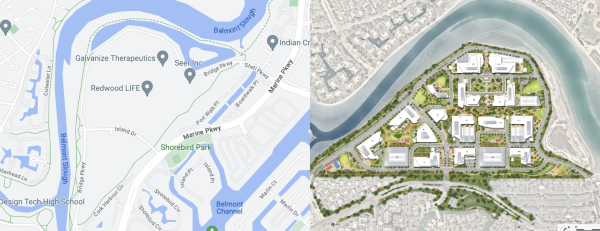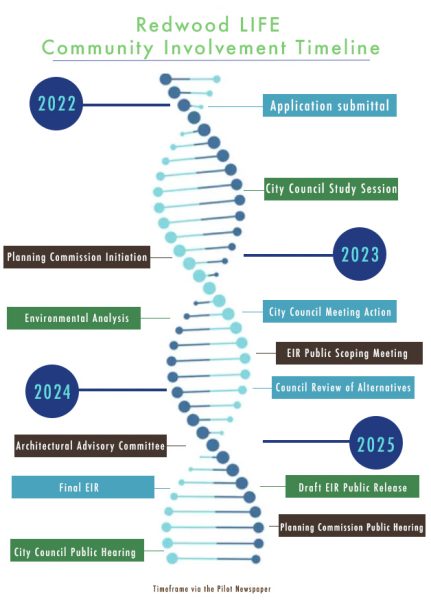Redwood Shores: a suburban area filled with families and wildlife in the Bay Area. With uniform houses lined up behind perfectly cut lawns, many view this small town as the ideal place to settle down.
However, according to the anti-development organization Save the Shores, this may soon change with the introduction of the Redwood LIFE project over the next 15 to 25 years. While Redwood LIFE promises a variety of new opportunities, such as parks, research labs, and community space, many Redwood Shores residents remain skeptical.
Longfellow is the real estate company that is carrying out this project. It is a life sciences-based investment firm located in cities such as London, Boston, and San Francisco. Adam Sichol and Jamison Peschel founded Longfellow back in 2009.
According to the Redwood LIFE Evolve website, “Longfellow proposes to evolve the outdated office park over time into a premier life science campus that thoughtfully engages its surrounding ecology and community.”
The purpose of Redwood LIFE is to create a versatile 3.3 million square feet site to benefit life science research companies as well as suburban residents. Some amenities open to the public will include walking trails, kitchen space, electric vehicle parking, and housing.

Many Redwood Shores residents have expressed their satisfaction with the area as it stands currently. One of these residents is Rona Gundrum, who has lived there for 35 years and joined the Redwood Shores Community Association (RSCA) in 2019.
“We moved to the Bay Area from the East Coast, and after house-hunting in several of the cities on the peninsula, we settled on Redwood Shores due to its peaceful, bayfront environment,” Gundrum said. “There is lots of open space and trails for walking, biking, living on the water, and access to boating and an abundance of avian wildlife. We could tell the change of seasons by which waterfowl would come and go. We found it an ideal spot to live, work, and raise a family.”
After news of the Longfellow development project first came out in 2021, many residents opposed the expansion’s size and were concerned about its impacts on the community.
“Not only would the Redwood LIFE project as currently proposed adversely affect the visual character of the property and community, but it would also have significant negative effects on our natural ecosystem and quality of life in the Shores,” Gundrum said.
The last two years have brought many citizens together to protest the proposed institution and advocate for a prevention plan.
According to Gundrum, “there have been several ‘call to action’ campaigns which generated hundreds of letters from community members to City Council expressing concerns about the proposed Redwood LIFE project,” one of these being Stop Redwood LIFE.
Brigitte and Earl Aiken founded this grassroots movement; they have been Redwood Shores residents for over 30 years.
“We never get involved in the community,” Brigitte Aiken, a former employee in the startup industry, said. “When we heard about Redwood LIFE, we decided perhaps we should get involved with the community and try to fight it off.”
The Aikens soon received recognition from many other residents as a small but determined group ready to take on the matter.
“We attended the RSCA meeting, but we realized that we are not compatible with the association… because of our approach and our mode, we think they take too much time to solve the issue,” Brigitte Aiken said.
Stop Redwood LIFE has been active since October 2021, making their voices heard through media such as Nextdoor and in-person meetings.
“To take action you can’t wait and see what the other people would do… I want to take initiative,” Brigitte said. “We got a lot of people volunteering and networking, and it’s really thanks to our 15 volunteers that would come in and help distribute flyers.”
Like most people in Redwood Shores, Brigitte and Earl Aiken can see potential benefits towards certain aspects of the Redwood LIFE project. Still, the main issue continues to be the drastic construction plans.
“This Redwood LIFE campus is bigger than the Apple campus,” Brigitte Aiken said. “The Apple campus is only 2.8 million square feet. This is huge. It is big.”
According to their website, Longfellow plans to “transform parking lots into parks with 47 acres of green space, trails, plazas, and promenades–including four new publicly accessible parks.”
“I am not against growth because actually some of my clients are in biotech,” Brigitte Aiken said. “But I am against something that is not suitable.”
Longfellow also promises to invest in protection from sea-level rise and stimulate the economy by providing thousands of “good union-wage jobs.”
“This is an issue that really hasn’t been addressed and doesn’t really affect Redwood Shores, but there is a bigger picture,” Earl Aiken said. “It’s what happens inevitably when you build some 100 lower income housing–it will bring in thousands of higher income professionals.”
According to Bay Area Equity Atlas, “Among all low-income households in the Bay Area, 31% live in neighborhoods that are gentrifying or at risk of gentrification.”
This has been a recurring cycle in neighborhoods all across the country. According to the Georgetown Journal on Poverty Law and Policy, gentrification is a direct cause of discrimination, statistically, with minority ethnicities.
“All of the development going on along the peninsula in biotech is going to lead to gentrification of our cities now,” Earl Aiken said. “But the long-term impact on the low to moderate-income residents of Redwood Shores and the other cities here is inevitably going to be negative… The demand for housing is going to increase and that’s going to make housing more valuable and it’s going to continue to drive out the low to moderate-income residents of Redwood Shores and the rest of the peninsula.”
Creating new opportunities for employment would require an immense amount of construction in the area to tear down existing infrastructure for new buildings and pathways.
“The people do not wish to have a massive campus like that to come in and disturb the quiet life,” Brigitte Aiken said. “We are quite proud of our little island, and it’s very convenient and logistically located and we don’t want something massive like that.”
Many citizens joined organizational groups such as Stop Redwood LIFE to express their concerns surrounding the 3.3 million square feet project.
“They do not want a disturbance to the quality of life in Redwood Shores… some are afraid that the birds during the winter would not come around and the traffic is going to be horrible if we anticipate about 10,000 employees to come in and work on the shores,” Brigitte Aiken said. “A lot also care about the environment–the animals and nature and also the pollution.”
Redwood Shores is known to be home to various species, such as birds, batrays, and swans. Since many houses are built around the town’s lagoon, restoring and protecting wildlife is a priority for numerous families.
The Redwood LIFE website says that they will evaluate the project in collaboration with the San Mateo County Department of Environmental Health, California Regional Water Quality Board, and a few other organizations focusing on wildlife research.
“There is substantial concern about disturbing the landfill that the current development is built on and whether that will release toxins or not,” Earl Aiken said. “It seems that there’s increasing concern about biohazards…and what level of biohazards would be used or allowed in Redwood LIFE.”
After receiving petition signatures and support from the public, Stop Redwood LIFE moved forward with their plans to meet with the Redwood City City Council on April 24 to voice their opinions to Longfellow representatives.
“I told them that the size of this campus is too big for this area and especially is too close to the residential area, and it will take you and the developers 25 years to complete,” Brigitte Aiken said. “That is not acceptable.”
Board members from the RSCA and Save the Shores also met with the City Council this past summer to express similar concerns about the company.

“With a 25-year phased development in which Longfellow is going to re-evaluate market conditions at each phase, the likelihood of the long-term need for a 3.3 million square feet office campus is, in our opinion, low,” Gundrum said. “I feel that demolishing a technology park that has an abundance of office space that is attractive and minimal in terms of height… is wasteful.”
According to Brigitte and Earl Aiken, the outcome of their meeting on July 26 was Jeff Gee, the Redwood City mayor, proposing a smaller alternative Redwood LIFE plan. It would involve hiring specialty consultants to analyze possible repercussions on the area and its people.
The RSCA and Save the Shores were met with the same answer and are currently waiting for a full report regarding the California Environmental Quality Act (CEQA).
“Due in large part to the diligence and advocacy of Save the Shores and RSCA…the Redwood City Council addressed community concerns about the proposed Redwood LIFE development by voting to engage outside, third party, consultants to study the project and help guide preparation of a revised project alternative,” Gundrum said.
In an article published by SFGATE on July 28, Longfellow’s Senior Director of Development, Peter Fritz, confirmed that the project plans are being re-evaluated but are ultimately still going to move forward.
“Our team is extremely thankful to the Redwood City Council and Planning Commission for their thoughtful review of the project–we are excited to see the results of an in-depth environmental review and ultimately take the next step in making this revolutionary campus a reality,” Fritz said.
While most initial concerns about the Longfellow development have been accounted for, the long-term effects of gentrification will continue to remain a future issue for other towns. As for Redwood Shores, the residents are currently waiting for more news about the finalized development plans which will determine the outcome of their protest efforts.
“I encourage all the supporters that we had to stand by,” Brigitte Aiken said. “My goal is we don’t stop until we receive a plan that is acceptable to the community and approved by the city council that it is a sure way we get something that we can live with.”
The Redwood City City Council is currently working alongside Longfellow and other consulting companies to determine the future of this wildlife-filled, family-friendly, suburban town.
“Together, we can ensure that the future development plan respects the Shores’ unique character and needs, preserves our environment, and maintains the balance between growth and sustainability,” Gundrum said.
**Longfellow ignored Scot Scoop’s media request.
This story was originally published on Scot Scoop News on November 8, 2023.




































